Understanding and applying consumer's perceptions of healthiness and freshness of food to a financially successful healthy fast food outlet
VerifiedAdded on 2023/06/03
|9
|1897
|270
AI Summary
This report explores the factors influencing consumers' perceptions and expectations towards healthiness and freshness of food products. It aims to develop a consumer concept for healthy fast food outlets that is present in the market. Consumers are becoming health conscious and interested in purchasing food products that are healthy and fresh. The review highlights the significance of natural and healthy food that determines the perception of the customer on healthiness and freshness. The nutrient value of food heavily influences the level of healthiness that the consumers seek for. The perceived healthiness and freshness in food enhances the value and satisfaction.
Contribute Materials
Your contribution can guide someone’s learning journey. Share your
documents today.

Running head: CONSUMER BEHAVIOUR
Consumer behaviour
Name of the student:
Name of the University:
Author note:
Consumer behaviour
Name of the student:
Name of the University:
Author note:
Secure Best Marks with AI Grader
Need help grading? Try our AI Grader for instant feedback on your assignments.

1CONSUMER BEHAVIOUR
Title
Understanding and applying consumer's perceptions of healthiness and freshness of food to a
financially successful healthy fast food outlet
Title
Understanding and applying consumer's perceptions of healthiness and freshness of food to a
financially successful healthy fast food outlet
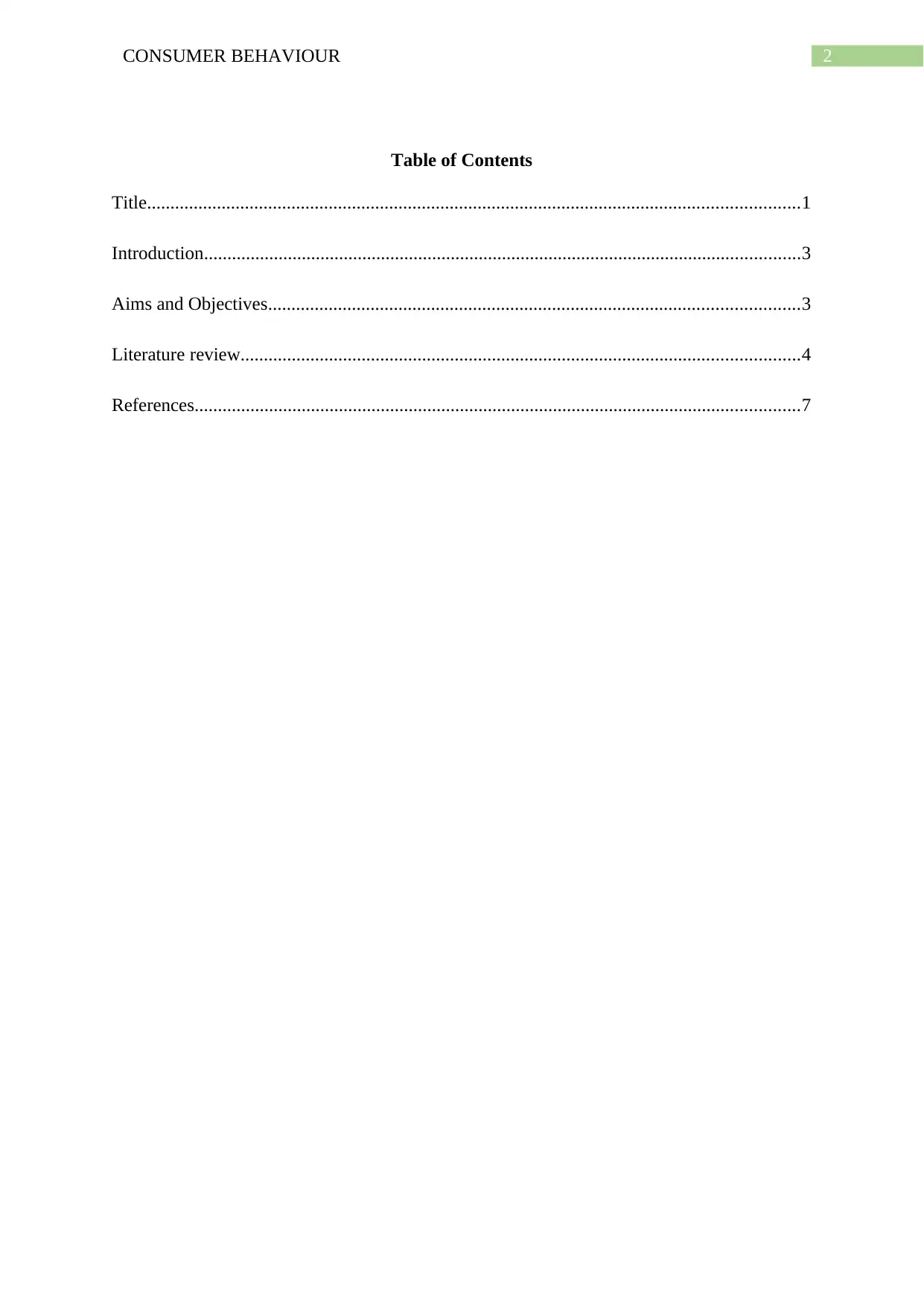
2CONSUMER BEHAVIOUR
Table of Contents
Title............................................................................................................................................1
Introduction................................................................................................................................3
Aims and Objectives..................................................................................................................3
Literature review........................................................................................................................4
References..................................................................................................................................7
Table of Contents
Title............................................................................................................................................1
Introduction................................................................................................................................3
Aims and Objectives..................................................................................................................3
Literature review........................................................................................................................4
References..................................................................................................................................7
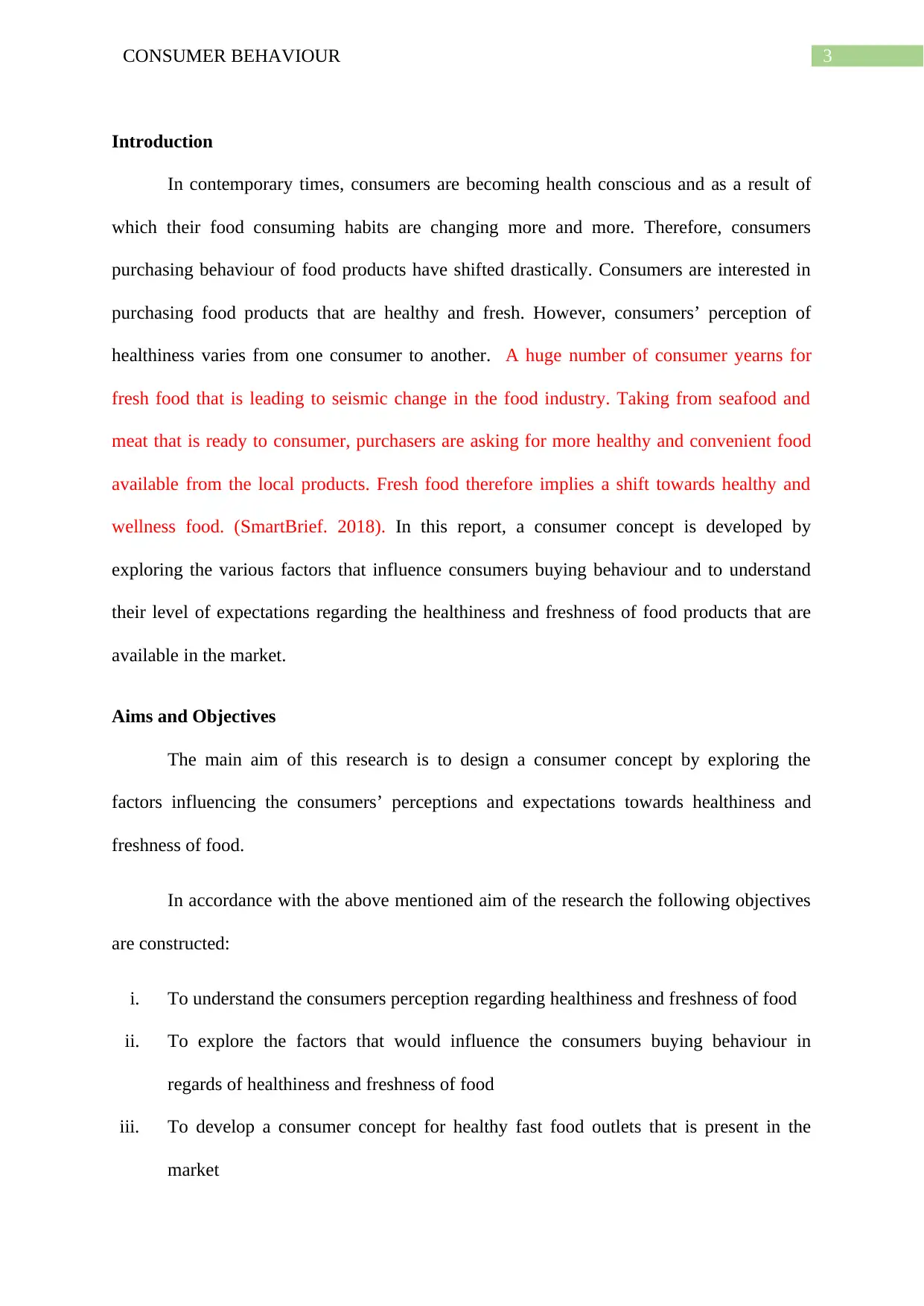
3CONSUMER BEHAVIOUR
Introduction
In contemporary times, consumers are becoming health conscious and as a result of
which their food consuming habits are changing more and more. Therefore, consumers
purchasing behaviour of food products have shifted drastically. Consumers are interested in
purchasing food products that are healthy and fresh. However, consumers’ perception of
healthiness varies from one consumer to another. A huge number of consumer yearns for
fresh food that is leading to seismic change in the food industry. Taking from seafood and
meat that is ready to consumer, purchasers are asking for more healthy and convenient food
available from the local products. Fresh food therefore implies a shift towards healthy and
wellness food. (SmartBrief. 2018). In this report, a consumer concept is developed by
exploring the various factors that influence consumers buying behaviour and to understand
their level of expectations regarding the healthiness and freshness of food products that are
available in the market.
Aims and Objectives
The main aim of this research is to design a consumer concept by exploring the
factors influencing the consumers’ perceptions and expectations towards healthiness and
freshness of food.
In accordance with the above mentioned aim of the research the following objectives
are constructed:
i. To understand the consumers perception regarding healthiness and freshness of food
ii. To explore the factors that would influence the consumers buying behaviour in
regards of healthiness and freshness of food
iii. To develop a consumer concept for healthy fast food outlets that is present in the
market
Introduction
In contemporary times, consumers are becoming health conscious and as a result of
which their food consuming habits are changing more and more. Therefore, consumers
purchasing behaviour of food products have shifted drastically. Consumers are interested in
purchasing food products that are healthy and fresh. However, consumers’ perception of
healthiness varies from one consumer to another. A huge number of consumer yearns for
fresh food that is leading to seismic change in the food industry. Taking from seafood and
meat that is ready to consumer, purchasers are asking for more healthy and convenient food
available from the local products. Fresh food therefore implies a shift towards healthy and
wellness food. (SmartBrief. 2018). In this report, a consumer concept is developed by
exploring the various factors that influence consumers buying behaviour and to understand
their level of expectations regarding the healthiness and freshness of food products that are
available in the market.
Aims and Objectives
The main aim of this research is to design a consumer concept by exploring the
factors influencing the consumers’ perceptions and expectations towards healthiness and
freshness of food.
In accordance with the above mentioned aim of the research the following objectives
are constructed:
i. To understand the consumers perception regarding healthiness and freshness of food
ii. To explore the factors that would influence the consumers buying behaviour in
regards of healthiness and freshness of food
iii. To develop a consumer concept for healthy fast food outlets that is present in the
market
Secure Best Marks with AI Grader
Need help grading? Try our AI Grader for instant feedback on your assignments.
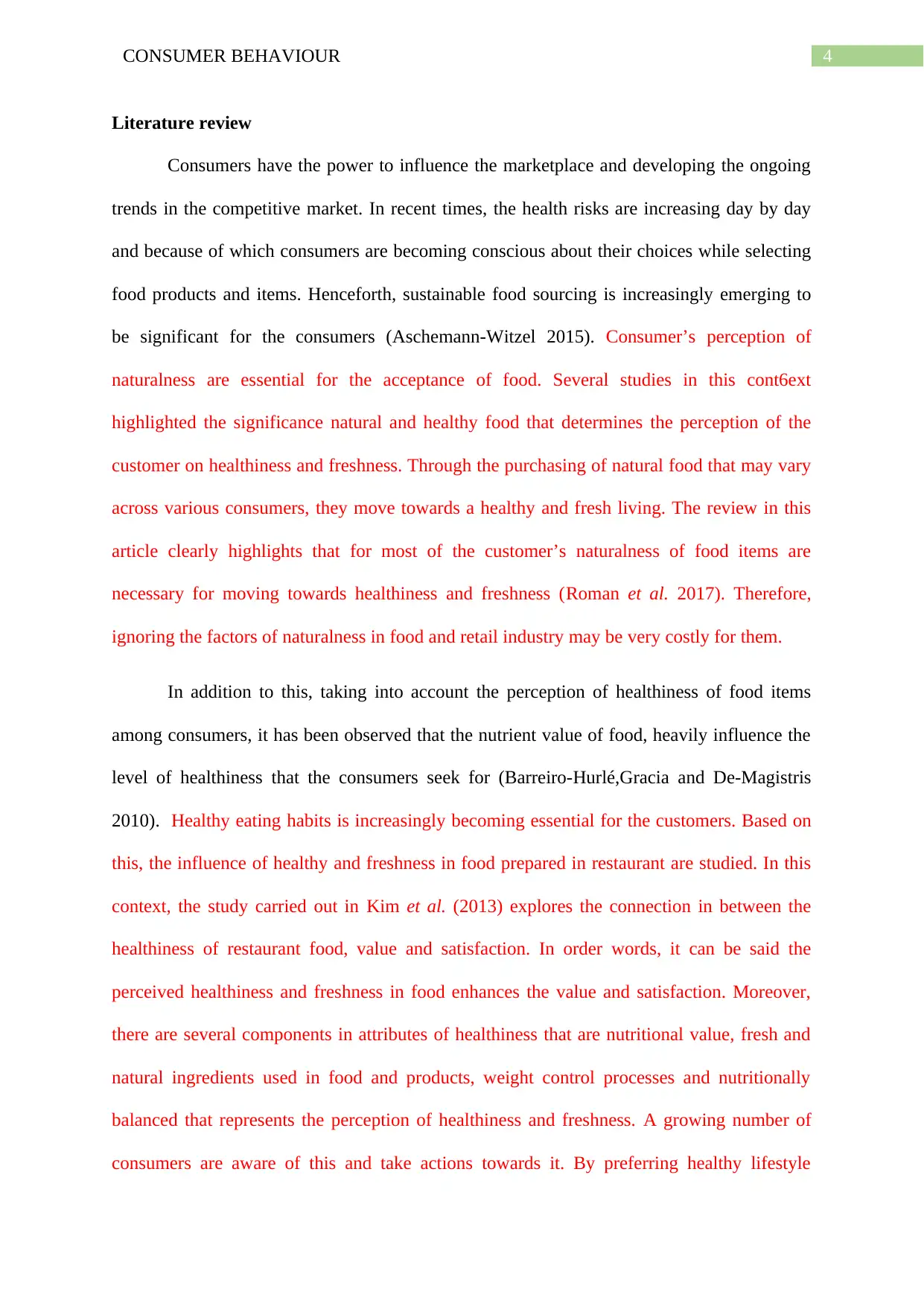
4CONSUMER BEHAVIOUR
Literature review
Consumers have the power to influence the marketplace and developing the ongoing
trends in the competitive market. In recent times, the health risks are increasing day by day
and because of which consumers are becoming conscious about their choices while selecting
food products and items. Henceforth, sustainable food sourcing is increasingly emerging to
be significant for the consumers (Aschemann-Witzel 2015). Consumer’s perception of
naturalness are essential for the acceptance of food. Several studies in this cont6ext
highlighted the significance natural and healthy food that determines the perception of the
customer on healthiness and freshness. Through the purchasing of natural food that may vary
across various consumers, they move towards a healthy and fresh living. The review in this
article clearly highlights that for most of the customer’s naturalness of food items are
necessary for moving towards healthiness and freshness (Roman et al. 2017). Therefore,
ignoring the factors of naturalness in food and retail industry may be very costly for them.
In addition to this, taking into account the perception of healthiness of food items
among consumers, it has been observed that the nutrient value of food, heavily influence the
level of healthiness that the consumers seek for (Barreiro-Hurlé,Gracia and De-Magistris
2010). Healthy eating habits is increasingly becoming essential for the customers. Based on
this, the influence of healthy and freshness in food prepared in restaurant are studied. In this
context, the study carried out in Kim et al. (2013) explores the connection in between the
healthiness of restaurant food, value and satisfaction. In order words, it can be said the
perceived healthiness and freshness in food enhances the value and satisfaction. Moreover,
there are several components in attributes of healthiness that are nutritional value, fresh and
natural ingredients used in food and products, weight control processes and nutritionally
balanced that represents the perception of healthiness and freshness. A growing number of
consumers are aware of this and take actions towards it. By preferring healthy lifestyle
Literature review
Consumers have the power to influence the marketplace and developing the ongoing
trends in the competitive market. In recent times, the health risks are increasing day by day
and because of which consumers are becoming conscious about their choices while selecting
food products and items. Henceforth, sustainable food sourcing is increasingly emerging to
be significant for the consumers (Aschemann-Witzel 2015). Consumer’s perception of
naturalness are essential for the acceptance of food. Several studies in this cont6ext
highlighted the significance natural and healthy food that determines the perception of the
customer on healthiness and freshness. Through the purchasing of natural food that may vary
across various consumers, they move towards a healthy and fresh living. The review in this
article clearly highlights that for most of the customer’s naturalness of food items are
necessary for moving towards healthiness and freshness (Roman et al. 2017). Therefore,
ignoring the factors of naturalness in food and retail industry may be very costly for them.
In addition to this, taking into account the perception of healthiness of food items
among consumers, it has been observed that the nutrient value of food, heavily influence the
level of healthiness that the consumers seek for (Barreiro-Hurlé,Gracia and De-Magistris
2010). Healthy eating habits is increasingly becoming essential for the customers. Based on
this, the influence of healthy and freshness in food prepared in restaurant are studied. In this
context, the study carried out in Kim et al. (2013) explores the connection in between the
healthiness of restaurant food, value and satisfaction. In order words, it can be said the
perceived healthiness and freshness in food enhances the value and satisfaction. Moreover,
there are several components in attributes of healthiness that are nutritional value, fresh and
natural ingredients used in food and products, weight control processes and nutritionally
balanced that represents the perception of healthiness and freshness. A growing number of
consumers are aware of this and take actions towards it. By preferring healthy lifestyle
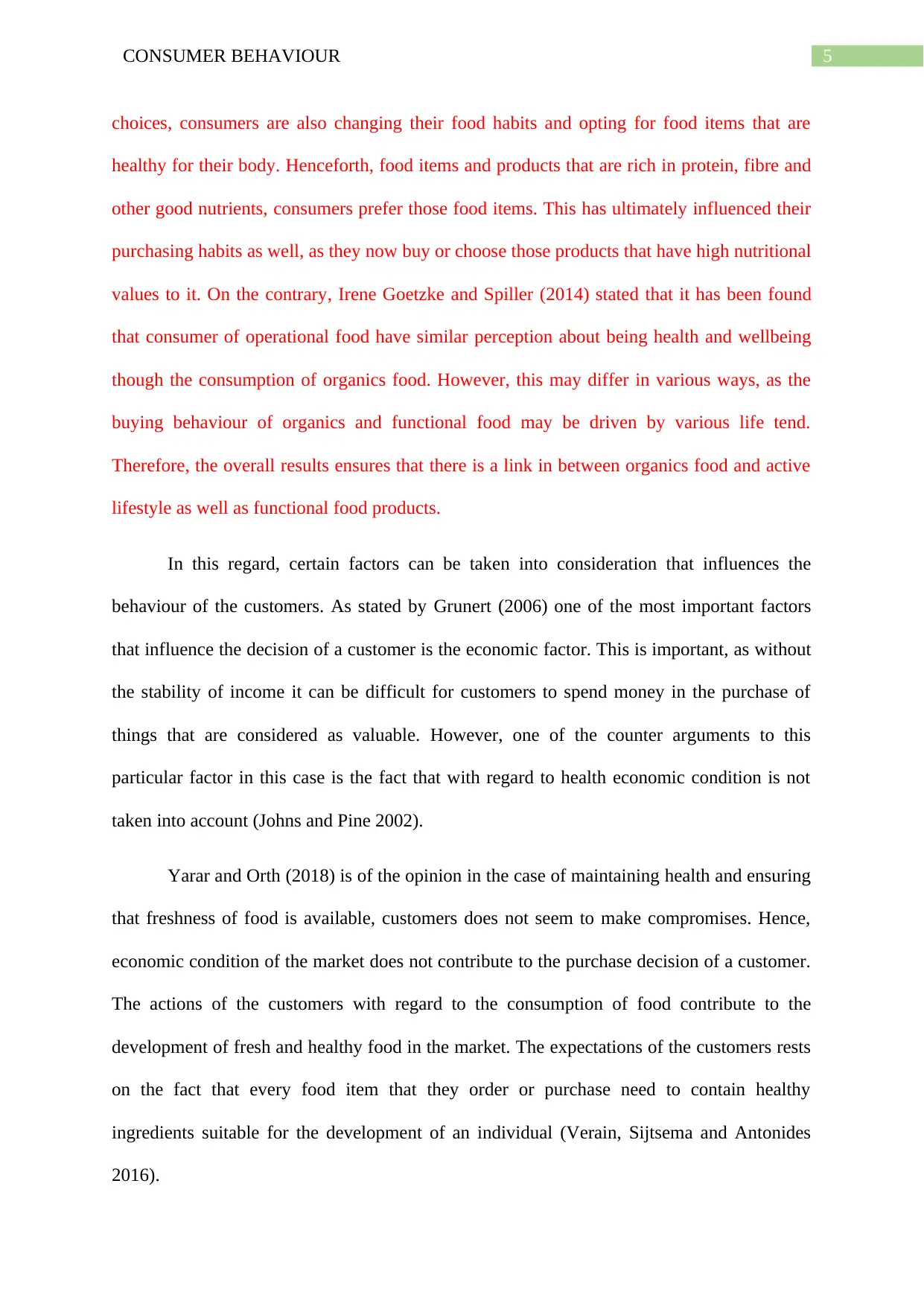
5CONSUMER BEHAVIOUR
choices, consumers are also changing their food habits and opting for food items that are
healthy for their body. Henceforth, food items and products that are rich in protein, fibre and
other good nutrients, consumers prefer those food items. This has ultimately influenced their
purchasing habits as well, as they now buy or choose those products that have high nutritional
values to it. On the contrary, Irene Goetzke and Spiller (2014) stated that it has been found
that consumer of operational food have similar perception about being health and wellbeing
though the consumption of organics food. However, this may differ in various ways, as the
buying behaviour of organics and functional food may be driven by various life tend.
Therefore, the overall results ensures that there is a link in between organics food and active
lifestyle as well as functional food products.
In this regard, certain factors can be taken into consideration that influences the
behaviour of the customers. As stated by Grunert (2006) one of the most important factors
that influence the decision of a customer is the economic factor. This is important, as without
the stability of income it can be difficult for customers to spend money in the purchase of
things that are considered as valuable. However, one of the counter arguments to this
particular factor in this case is the fact that with regard to health economic condition is not
taken into account (Johns and Pine 2002).
Yarar and Orth (2018) is of the opinion in the case of maintaining health and ensuring
that freshness of food is available, customers does not seem to make compromises. Hence,
economic condition of the market does not contribute to the purchase decision of a customer.
The actions of the customers with regard to the consumption of food contribute to the
development of fresh and healthy food in the market. The expectations of the customers rests
on the fact that every food item that they order or purchase need to contain healthy
ingredients suitable for the development of an individual (Verain, Sijtsema and Antonides
2016).
choices, consumers are also changing their food habits and opting for food items that are
healthy for their body. Henceforth, food items and products that are rich in protein, fibre and
other good nutrients, consumers prefer those food items. This has ultimately influenced their
purchasing habits as well, as they now buy or choose those products that have high nutritional
values to it. On the contrary, Irene Goetzke and Spiller (2014) stated that it has been found
that consumer of operational food have similar perception about being health and wellbeing
though the consumption of organics food. However, this may differ in various ways, as the
buying behaviour of organics and functional food may be driven by various life tend.
Therefore, the overall results ensures that there is a link in between organics food and active
lifestyle as well as functional food products.
In this regard, certain factors can be taken into consideration that influences the
behaviour of the customers. As stated by Grunert (2006) one of the most important factors
that influence the decision of a customer is the economic factor. This is important, as without
the stability of income it can be difficult for customers to spend money in the purchase of
things that are considered as valuable. However, one of the counter arguments to this
particular factor in this case is the fact that with regard to health economic condition is not
taken into account (Johns and Pine 2002).
Yarar and Orth (2018) is of the opinion in the case of maintaining health and ensuring
that freshness of food is available, customers does not seem to make compromises. Hence,
economic condition of the market does not contribute to the purchase decision of a customer.
The actions of the customers with regard to the consumption of food contribute to the
development of fresh and healthy food in the market. The expectations of the customers rests
on the fact that every food item that they order or purchase need to contain healthy
ingredients suitable for the development of an individual (Verain, Sijtsema and Antonides
2016).
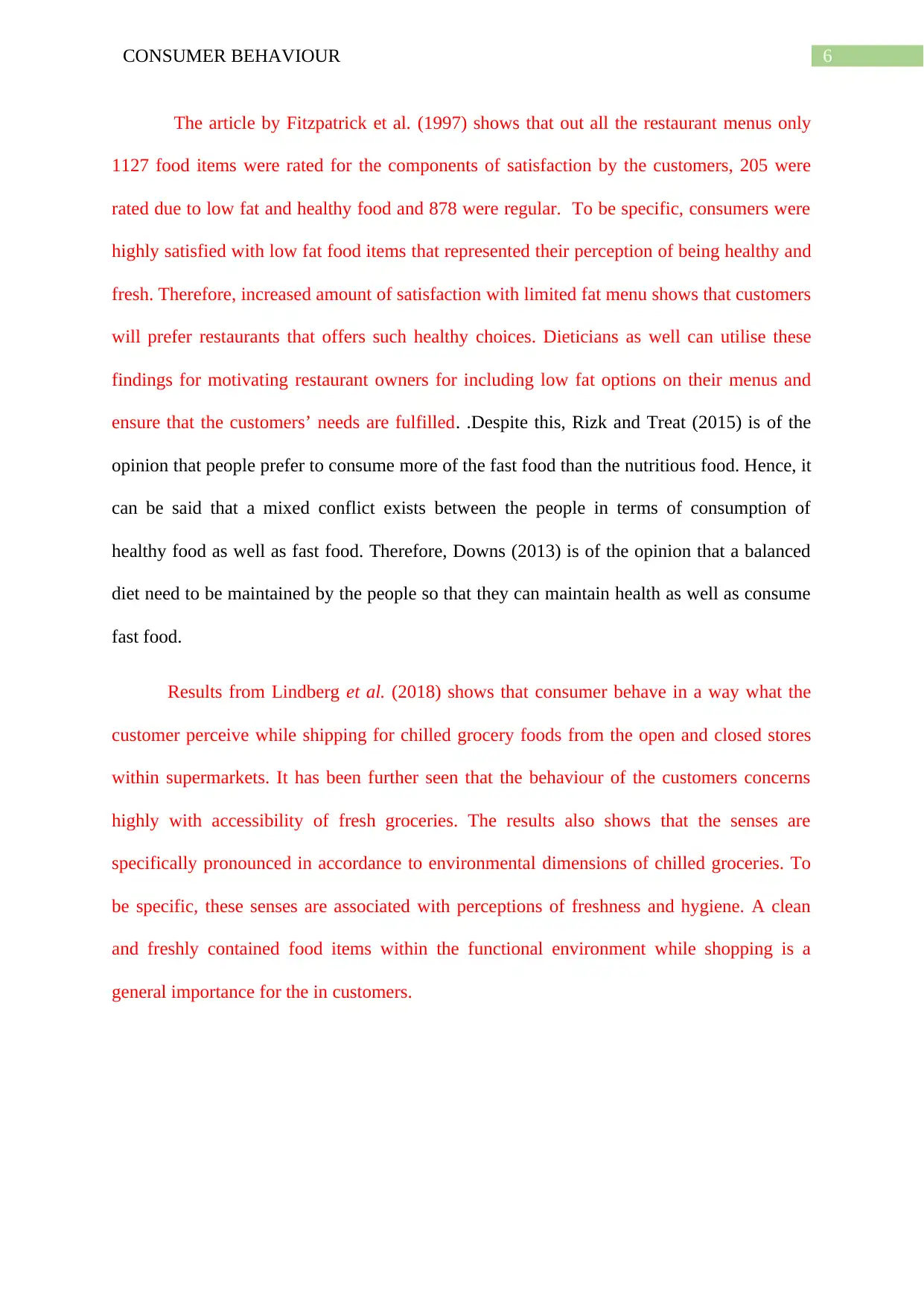
6CONSUMER BEHAVIOUR
The article by Fitzpatrick et al. (1997) shows that out all the restaurant menus only
1127 food items were rated for the components of satisfaction by the customers, 205 were
rated due to low fat and healthy food and 878 were regular. To be specific, consumers were
highly satisfied with low fat food items that represented their perception of being healthy and
fresh. Therefore, increased amount of satisfaction with limited fat menu shows that customers
will prefer restaurants that offers such healthy choices. Dieticians as well can utilise these
findings for motivating restaurant owners for including low fat options on their menus and
ensure that the customers’ needs are fulfilled. .Despite this, Rizk and Treat (2015) is of the
opinion that people prefer to consume more of the fast food than the nutritious food. Hence, it
can be said that a mixed conflict exists between the people in terms of consumption of
healthy food as well as fast food. Therefore, Downs (2013) is of the opinion that a balanced
diet need to be maintained by the people so that they can maintain health as well as consume
fast food.
Results from Lindberg et al. (2018) shows that consumer behave in a way what the
customer perceive while shipping for chilled grocery foods from the open and closed stores
within supermarkets. It has been further seen that the behaviour of the customers concerns
highly with accessibility of fresh groceries. The results also shows that the senses are
specifically pronounced in accordance to environmental dimensions of chilled groceries. To
be specific, these senses are associated with perceptions of freshness and hygiene. A clean
and freshly contained food items within the functional environment while shopping is a
general importance for the in customers.
The article by Fitzpatrick et al. (1997) shows that out all the restaurant menus only
1127 food items were rated for the components of satisfaction by the customers, 205 were
rated due to low fat and healthy food and 878 were regular. To be specific, consumers were
highly satisfied with low fat food items that represented their perception of being healthy and
fresh. Therefore, increased amount of satisfaction with limited fat menu shows that customers
will prefer restaurants that offers such healthy choices. Dieticians as well can utilise these
findings for motivating restaurant owners for including low fat options on their menus and
ensure that the customers’ needs are fulfilled. .Despite this, Rizk and Treat (2015) is of the
opinion that people prefer to consume more of the fast food than the nutritious food. Hence, it
can be said that a mixed conflict exists between the people in terms of consumption of
healthy food as well as fast food. Therefore, Downs (2013) is of the opinion that a balanced
diet need to be maintained by the people so that they can maintain health as well as consume
fast food.
Results from Lindberg et al. (2018) shows that consumer behave in a way what the
customer perceive while shipping for chilled grocery foods from the open and closed stores
within supermarkets. It has been further seen that the behaviour of the customers concerns
highly with accessibility of fresh groceries. The results also shows that the senses are
specifically pronounced in accordance to environmental dimensions of chilled groceries. To
be specific, these senses are associated with perceptions of freshness and hygiene. A clean
and freshly contained food items within the functional environment while shopping is a
general importance for the in customers.
Paraphrase This Document
Need a fresh take? Get an instant paraphrase of this document with our AI Paraphraser
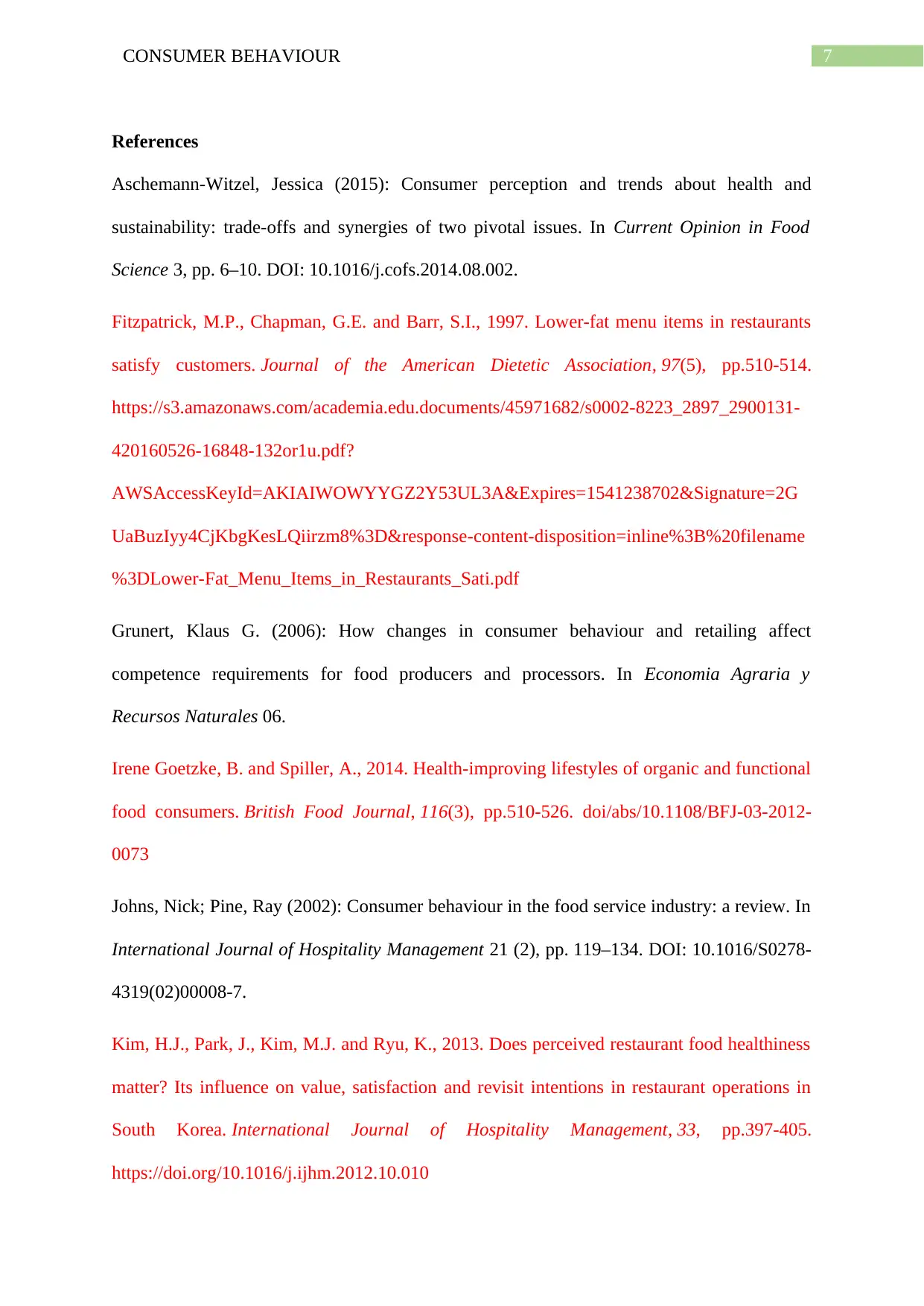
7CONSUMER BEHAVIOUR
References
Aschemann-Witzel, Jessica (2015): Consumer perception and trends about health and
sustainability: trade-offs and synergies of two pivotal issues. In Current Opinion in Food
Science 3, pp. 6–10. DOI: 10.1016/j.cofs.2014.08.002.
Fitzpatrick, M.P., Chapman, G.E. and Barr, S.I., 1997. Lower-fat menu items in restaurants
satisfy customers. Journal of the American Dietetic Association, 97(5), pp.510-514.
https://s3.amazonaws.com/academia.edu.documents/45971682/s0002-8223_2897_2900131-
420160526-16848-132or1u.pdf?
AWSAccessKeyId=AKIAIWOWYYGZ2Y53UL3A&Expires=1541238702&Signature=2G
UaBuzIyy4CjKbgKesLQiirzm8%3D&response-content-disposition=inline%3B%20filename
%3DLower-Fat_Menu_Items_in_Restaurants_Sati.pdf
Grunert, Klaus G. (2006): How changes in consumer behaviour and retailing affect
competence requirements for food producers and processors. In Economia Agraria y
Recursos Naturales 06.
Irene Goetzke, B. and Spiller, A., 2014. Health-improving lifestyles of organic and functional
food consumers. British Food Journal, 116(3), pp.510-526. doi/abs/10.1108/BFJ-03-2012-
0073
Johns, Nick; Pine, Ray (2002): Consumer behaviour in the food service industry: a review. In
International Journal of Hospitality Management 21 (2), pp. 119–134. DOI: 10.1016/S0278-
4319(02)00008-7.
Kim, H.J., Park, J., Kim, M.J. and Ryu, K., 2013. Does perceived restaurant food healthiness
matter? Its influence on value, satisfaction and revisit intentions in restaurant operations in
South Korea. International Journal of Hospitality Management, 33, pp.397-405.
https://doi.org/10.1016/j.ijhm.2012.10.010
References
Aschemann-Witzel, Jessica (2015): Consumer perception and trends about health and
sustainability: trade-offs and synergies of two pivotal issues. In Current Opinion in Food
Science 3, pp. 6–10. DOI: 10.1016/j.cofs.2014.08.002.
Fitzpatrick, M.P., Chapman, G.E. and Barr, S.I., 1997. Lower-fat menu items in restaurants
satisfy customers. Journal of the American Dietetic Association, 97(5), pp.510-514.
https://s3.amazonaws.com/academia.edu.documents/45971682/s0002-8223_2897_2900131-
420160526-16848-132or1u.pdf?
AWSAccessKeyId=AKIAIWOWYYGZ2Y53UL3A&Expires=1541238702&Signature=2G
UaBuzIyy4CjKbgKesLQiirzm8%3D&response-content-disposition=inline%3B%20filename
%3DLower-Fat_Menu_Items_in_Restaurants_Sati.pdf
Grunert, Klaus G. (2006): How changes in consumer behaviour and retailing affect
competence requirements for food producers and processors. In Economia Agraria y
Recursos Naturales 06.
Irene Goetzke, B. and Spiller, A., 2014. Health-improving lifestyles of organic and functional
food consumers. British Food Journal, 116(3), pp.510-526. doi/abs/10.1108/BFJ-03-2012-
0073
Johns, Nick; Pine, Ray (2002): Consumer behaviour in the food service industry: a review. In
International Journal of Hospitality Management 21 (2), pp. 119–134. DOI: 10.1016/S0278-
4319(02)00008-7.
Kim, H.J., Park, J., Kim, M.J. and Ryu, K., 2013. Does perceived restaurant food healthiness
matter? Its influence on value, satisfaction and revisit intentions in restaurant operations in
South Korea. International Journal of Hospitality Management, 33, pp.397-405.
https://doi.org/10.1016/j.ijhm.2012.10.010
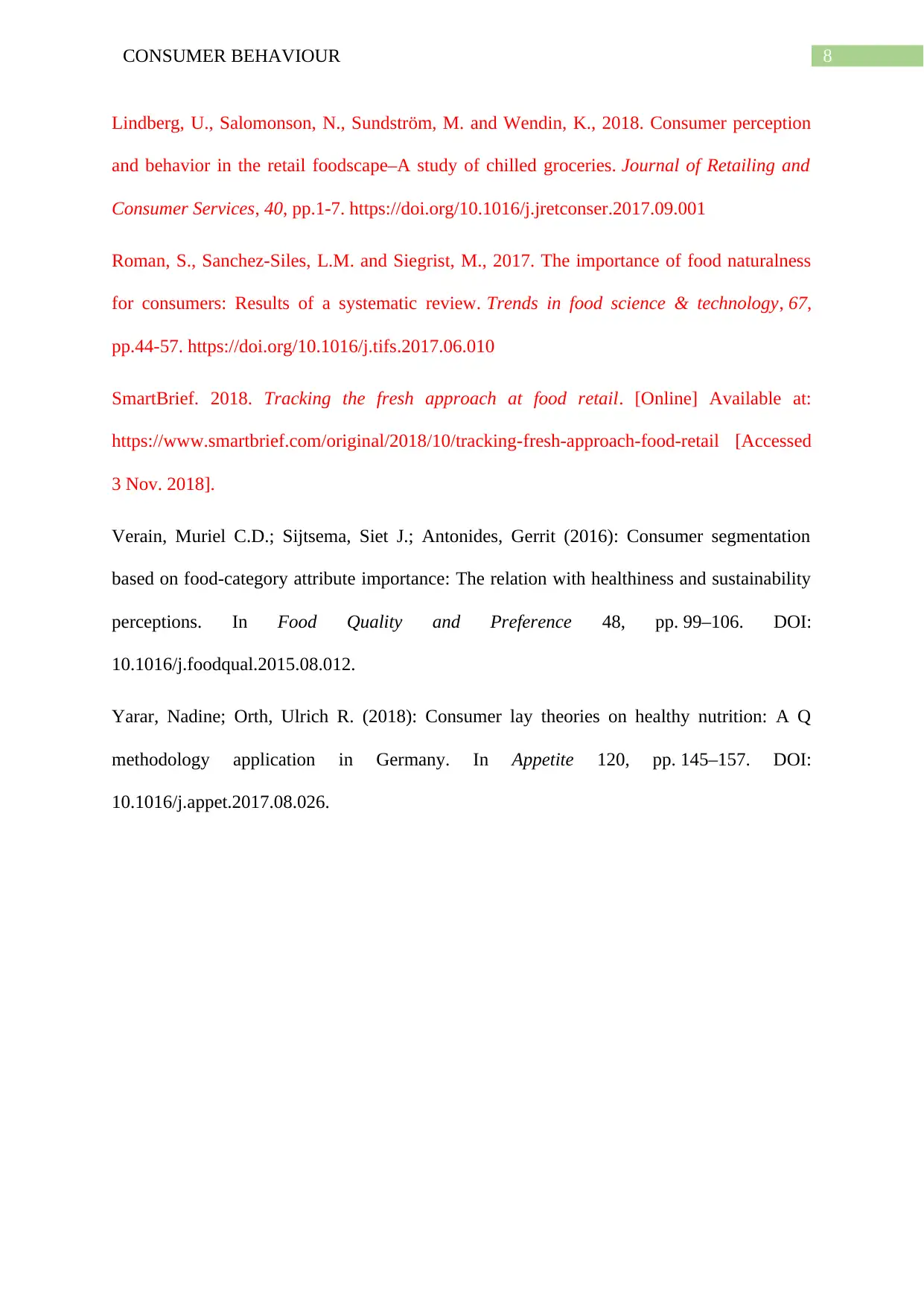
8CONSUMER BEHAVIOUR
Lindberg, U., Salomonson, N., Sundström, M. and Wendin, K., 2018. Consumer perception
and behavior in the retail foodscape–A study of chilled groceries. Journal of Retailing and
Consumer Services, 40, pp.1-7. https://doi.org/10.1016/j.jretconser.2017.09.001
Roman, S., Sanchez-Siles, L.M. and Siegrist, M., 2017. The importance of food naturalness
for consumers: Results of a systematic review. Trends in food science & technology, 67,
pp.44-57. https://doi.org/10.1016/j.tifs.2017.06.010
SmartBrief. 2018. Tracking the fresh approach at food retail. [Online] Available at:
https://www.smartbrief.com/original/2018/10/tracking-fresh-approach-food-retail [Accessed
3 Nov. 2018].
Verain, Muriel C.D.; Sijtsema, Siet J.; Antonides, Gerrit (2016): Consumer segmentation
based on food-category attribute importance: The relation with healthiness and sustainability
perceptions. In Food Quality and Preference 48, pp. 99–106. DOI:
10.1016/j.foodqual.2015.08.012.
Yarar, Nadine; Orth, Ulrich R. (2018): Consumer lay theories on healthy nutrition: A Q
methodology application in Germany. In Appetite 120, pp. 145–157. DOI:
10.1016/j.appet.2017.08.026.
Lindberg, U., Salomonson, N., Sundström, M. and Wendin, K., 2018. Consumer perception
and behavior in the retail foodscape–A study of chilled groceries. Journal of Retailing and
Consumer Services, 40, pp.1-7. https://doi.org/10.1016/j.jretconser.2017.09.001
Roman, S., Sanchez-Siles, L.M. and Siegrist, M., 2017. The importance of food naturalness
for consumers: Results of a systematic review. Trends in food science & technology, 67,
pp.44-57. https://doi.org/10.1016/j.tifs.2017.06.010
SmartBrief. 2018. Tracking the fresh approach at food retail. [Online] Available at:
https://www.smartbrief.com/original/2018/10/tracking-fresh-approach-food-retail [Accessed
3 Nov. 2018].
Verain, Muriel C.D.; Sijtsema, Siet J.; Antonides, Gerrit (2016): Consumer segmentation
based on food-category attribute importance: The relation with healthiness and sustainability
perceptions. In Food Quality and Preference 48, pp. 99–106. DOI:
10.1016/j.foodqual.2015.08.012.
Yarar, Nadine; Orth, Ulrich R. (2018): Consumer lay theories on healthy nutrition: A Q
methodology application in Germany. In Appetite 120, pp. 145–157. DOI:
10.1016/j.appet.2017.08.026.
1 out of 9
Related Documents
Your All-in-One AI-Powered Toolkit for Academic Success.
+13062052269
info@desklib.com
Available 24*7 on WhatsApp / Email
![[object Object]](/_next/static/media/star-bottom.7253800d.svg)
Unlock your academic potential
© 2024 | Zucol Services PVT LTD | All rights reserved.





